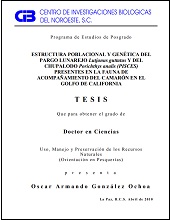| dc.contributor | JUANA LOPEZ MARTINEZ | |
| dc.contributor | NORMA YOLANDA HERNANDEZ SAAVEDRA | |
| dc.creator | OSCAR ARMANDO GONZÁLEZ OCHOA | |
| dc.date | 2010 | |
| dc.identifier | http://cibnor.repositorioinstitucional.mx/jspui/handle/1001/1503 | |
| dc.identifier.uri | http://dspace.cibnor.mx:8080/handle/123456789/2854 | |
| dc.description | "Existen limitados estudios de diversidad poblacional fenotípica o genotípica de las especies que conforman la Fauna de Acompañamiento del camarón (FAC) en el Golfo de California. El presente trabajo evaluó la existencia de estructura poblacional y genética del pargo lunarejo Lutjanus guttatus y el chupalodo Porichthys analis a partir de muestras provenientes de la FAC y de la pesca ribereña. El pargo lunarejo no presentó características poblacionales diferentes y la relación Longitud-Peso (P = 0.000092 LE3.0509; LE, longitud estándar) mostró un crecimiento isométrico. Se construyeron distribuciones de frecuencia de tallas y mediante ELEFAN I se estimaron los parámetros de crecimiento de von Bertalanffy, que fueron L∞= 515 mm (LE) y K= 0.13 e indican una especie longeva (23 años). La mortalidad natural (M = 0.35) se estimó con las ecuaciones empírica de Pauly y de Ralston, y la mortalidad total (Z = 1.0) con la ecuación de curva de captura convertida en tallas. El patrón de reclutamiento se estimó mediante ELEFAN II y se extendió durante todo el año, con máximos en primavera-verano. La talla de primera captura (LC50= 80 mm, LE) se estimó por ajuste no lineal de mínimos cuadrados. La proporción sexual fue 1:1. En el chupalodo tampoco existen elementos para inferir una estructura poblacional. La relación talla-peso fue P = 000092 LE3.0509; los parámetros de crecimiento L∞ = 352 mm de LE y K = 0.5 indican una especie de moderadamente longeva (12 años). La mortalidad natural (M = 0,97) y la total (Z = 4,67) aparecen altas. El patrón de reclutamiento es mayor durante primavera-verano. La proporción sexual M:F fue 1,65:1 y la talla de primera madurez (Lm50) es menor en el norte (148 mm LE) que en el centro y sur (184 mm LE; global, 157 mm LE) y en ambos casos mayor que la talla de primera captura (LC50 = 135 mm LE). Se obtuvo ADN total que se usó como templado en la amplificación del gen 16S ADNmt (≈ iv 467 pb) mediante PCR, se secuenciaron y alinearon mediante Clustal W o Muscle, y obtuvieron 33 haplotipos para el pargo lunarejo y 39 para el chupalodo. Se evaluaron las relaciones de similitud y filogenia mediante la construcción de árboles con los criterios de Vecino mas Cercano (Neigbbour-Joining), Máxima Parsimonia con el programa MEGA y Máxima Verosimilitud mediante el programa BOSQUE..." | |
| dc.description | "There are limited studies on population phenotypic or genotypic diversity on fish species that make up the Shrimp bycatch (FAC) in the Gulf of California (GC). The present study evaluated the existence of population structure and genetic structure of spotted rose snapper Lutjanus guttatus and darkedge midshipman fish Porichthys analis from shrimp bycathed and artisanal fishery samples in the GC. The spotted rose snapper did not show a population structure and length-weight relationship (W = 0.000092 SL3.0509, SL, standard length) was estimated by least squares. Frequency distributions were constructed by ELEFAN I, size and growth parameters of von Bertalanffy model were L ∞ = 515 mm (LE) and K = 0.13 indicating a long-lived species (23 years). Natural mortality (M = 0.35) was estimated using Pauly´s empirical and Ralston´s equations, and total mortality (Z = 1.0) with length converted catch curve equation. The recruitment pattern was estimated by ELEFAN II and was extended throughout the year, with peaks in spring and summer. The mean size at capture (LC50 = 80 mm, SL) was estimated by nonlinear least squares. The sex ratio M:F was 1:1. Elements to infer a population structure in darkedge midshipman were not found either. The length-weight relationship was W = 000,092 SL3.0509, the growth parameters L ∞ = 352 mm SL and K = 0.5 indicates a short life span (12 years). Natural (M = 0.97) and total mortality (Z = 4.67) were high. The recruitment pattern is highest during spring and summer. The sex ratio M: F was 1,65:1 and mean size at first maturity (Lm50) is lower in the north (148 mm SL) than in the center and southern (184 mm SL; overall, 157 mm SL) part of the Gulf and in both cases greater than the mean size at capture (LC50 = 135 mm SL). For both species total DNA was obtained and used as template in PCR amplification of 16S mtDNA (≈ 467 pb), the amplicons were sequenced and aligned by Clustal W or vi Muscle program, yielding 33 haplotypes for spotted rose snapper and 39 for darkedge midshipman. We evaluated the homology relationships between haplotypes by Neighbor- Joining, Maximum Parsimony (MEGA program) and Maximum Likelihood (BOSQUE program) trees.." | |
| dc.format | application/pdf | |
| dc.language | spa | |
| dc.publisher | Centro de Investigaciones Biológicas del Noroeste, S.C. | |
| dc.rights | info:eu-repo/semantics/openAccess | |
| dc.rights | http://creativecommons.org/licenses/by-nc-nd/4.0 | |
| dc.subject | info:eu-repo/classification/AUTOR/Porichthys analis, Lutjanus guttatus, estructura | |
| dc.subject | info:eu-repo/classification/AUTOR/Structure | |
| dc.subject | info:eu-repo/classification/cti/6 | |
| dc.subject | info:eu-repo/classification/cti/31 | |
| dc.subject | info:eu-repo/classification/cti/3105 | |
| dc.subject | info:eu-repo/classification/cti/310510 | |
| dc.subject | info:eu-repo/classification/cti/310510 | |
| dc.title | Estructura poblacional y genética del pargo lunarejo Lutjanus guttatus y del chupalodo Porichthys analis (Pisces) Presentes en la fauna de acompañamiento del camarón en el Golfo de California | |
| dc.type | info:eu-repo/semantics/doctoralThesis | |
| dc.type | info:eu-repo/semantics/acceptedVersion | |


